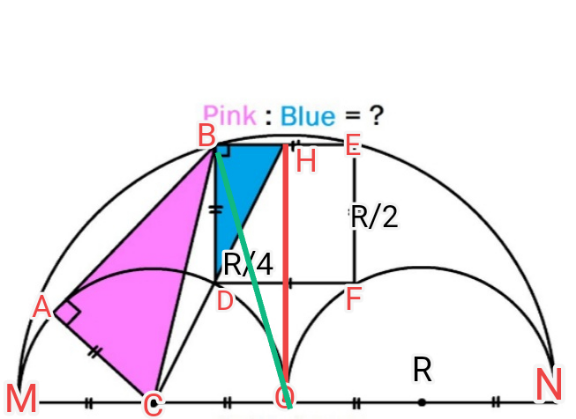
Question Number 201035 by sonukgindia last updated on 28/Nov/23

Commented by mr W last updated on 28/Nov/23

$${the}\:{side}\:{length}\:{of}\:{the}\:{square}\:{can}\:{not} \\ $$$${be}\:{equal}\:{to}\:{the}\:{radius}\:{of}\:{the}\:{smaller} \\ $$$${semi}−{circles}! \\ $$
Commented by mr W last updated on 28/Nov/23

Answered by a.lgnaoui last updated on 29/Nov/23

$$\boldsymbol{\mathrm{P}}\mathrm{ink}\:\mathrm{triangle}\:\:\:\:\:\:\boldsymbol{\mathrm{ABC}} \\ $$$$\boldsymbol{\mathrm{B}}\mathrm{lue}\:\mathrm{triangle}\:\:\:\:\:\:\:\boldsymbol{\mathrm{BDE}} \\ $$$$\boldsymbol{\mathrm{BD}}=\mathrm{2}×\frac{\boldsymbol{\mathrm{R}}}{\mathrm{4}}=\frac{\boldsymbol{\mathrm{R}}}{\mathrm{2}}\:\:\:\:\:\:\:\:\boldsymbol{\mathrm{BH}}=\frac{\boldsymbol{\mathrm{R}}}{\mathrm{4}} \\ $$$$\Rightarrow\boldsymbol{\mathrm{Blue}}\:\:\boldsymbol{\mathrm{Area}}=\left(\frac{\boldsymbol{\mathrm{R}}}{\mathrm{4}}×\frac{\boldsymbol{\mathrm{R}}}{\mathrm{2}}\right)×\frac{\mathrm{1}}{\mathrm{2}}=\frac{\boldsymbol{\mathrm{R}}^{\mathrm{2}} }{\mathrm{16}}\:\:\:\left(\mathrm{1}\right) \\ $$$$\boldsymbol{\mathrm{BC}}//\boldsymbol{\mathrm{OE}}\:\:\:\:\:\:\boldsymbol{\mathrm{BC}}^{\mathrm{2}} =\boldsymbol{\mathrm{OH}}^{\mathrm{2}} +\boldsymbol{\mathrm{BH}}^{\mathrm{2}} =\boldsymbol{\mathrm{OB}}^{\mathrm{2}} \\ $$$$\:\:\boldsymbol{\mathrm{R}}^{\mathrm{2}} =\boldsymbol{\mathrm{OH}}^{\mathrm{2}} +\frac{\boldsymbol{\mathrm{R}}^{\mathrm{2}} }{\mathrm{4}^{\mathrm{2}} }\:=\boldsymbol{\mathrm{AB}}^{\mathrm{2}} +\frac{\boldsymbol{\mathrm{R}}^{\mathrm{2}} }{\mathrm{4}} \\ $$$$\Rightarrow\:\:\:\:\:\:\boldsymbol{\mathrm{AB}}=\frac{\boldsymbol{\mathrm{R}}\sqrt{\mathrm{3}}}{\mathrm{2}}\:\:\:\:\:\:\:\:\boldsymbol{\mathrm{AC}}=\frac{\boldsymbol{\mathrm{R}}}{\mathrm{2}} \\ $$$$\:\boldsymbol{\mathrm{Pink}}\:\boldsymbol{\mathrm{Area}}=\:\frac{\mathrm{1}}{\mathrm{2}}\:\left(\boldsymbol{\mathrm{AB}}×\boldsymbol{\mathrm{AC}}\right)=\frac{\boldsymbol{\mathrm{R}}^{\mathrm{2}} \sqrt{\mathrm{3}}}{\mathrm{8}} \\ $$$$ \\ $$$$ \\ $$$$\frac{\boldsymbol{\mathrm{Pink}}\:}{\boldsymbol{\mathrm{Blue}}}=\frac{\frac{\boldsymbol{\mathrm{R}}^{\mathrm{2}} \sqrt{\mathrm{3}}}{\mathrm{8}}}{\frac{\boldsymbol{\mathrm{R}}^{\mathrm{2}} }{\mathrm{16}}}=\frac{\boldsymbol{\mathrm{R}}^{\mathrm{2}} \sqrt{\mathrm{3}}}{\mathrm{8}}×\frac{\mathrm{16}}{\boldsymbol{\mathrm{R}}^{\mathrm{2}} }\:\:\:\:\:=\mathrm{2}\sqrt{\mathrm{3}}\:\mathrm{X} \\ $$$$\left({Voir}\:{Resultat}\:{exact}\:\:{dessous}:\:\mathrm{3},\mathrm{1334}\right) \\ $$$$\:\: \\ $$
Commented by a.lgnaoui last updated on 28/Nov/23

Commented by mr W last updated on 28/Nov/23

$${wrong}! \\ $$$${BD}={DF}\neq\frac{{R}}{\mathrm{2}} \\ $$
Commented by a.lgnaoui last updated on 28/Nov/23

$$\mathrm{OM}=\mathrm{ON}=\mathrm{R} \\ $$
Commented by mr W last updated on 29/Nov/23

$${the}\:{side}\:{length}\:{of}\:{the}\:{square}\:{is}\:{not} \\ $$$${equal}\:{to}\:{the}\:{radius}\:{of}\:{smaller}\:{semi} \\ $$$${circles}! \\ $$
Commented by a.lgnaoui last updated on 29/Nov/23

$$\mathrm{soit}\:\:\boldsymbol{\alpha}=\measuredangle\mathrm{CHO}\:\:\:\:\mathrm{tan}\:\boldsymbol{\alpha}=\frac{\boldsymbol{\mathrm{x}}/\mathrm{2}}{\boldsymbol{\mathrm{x}}}=\frac{\mathrm{1}}{\mathrm{2}} \\ $$$$\Rightarrow\:\:\frac{\mathrm{OC}}{\mathrm{OH}}=\frac{\mathrm{1}}{\mathrm{2}}=\frac{\frac{\boldsymbol{\mathrm{R}}}{\mathrm{2}}}{\boldsymbol{\mathrm{x}}+\boldsymbol{\mathrm{CD}}\mathrm{cos}\:\boldsymbol{\alpha}} \\ $$$$\:\mathrm{1}=\frac{\boldsymbol{\mathrm{R}}}{\boldsymbol{\mathrm{x}}+\frac{\boldsymbol{\mathrm{R}}}{\mathrm{2}}\mathrm{cos}\:\mathrm{26},\mathrm{56}}\:\:\boldsymbol{\alpha}=\:\left(\mathrm{tan}\:^{−\mathrm{1}} \frac{\mathrm{1}}{\mathrm{2}}\right)=\mathrm{26},\mathrm{56} \\ $$$$\mathrm{donc}\:\:\frac{\mathrm{2}\boldsymbol{\mathrm{R}}}{\mathrm{2}\boldsymbol{\mathrm{x}}+\boldsymbol{\mathrm{R}}\mathrm{cos}\:\mathrm{26},\mathrm{56}}=\mathrm{1} \\ $$$$\:\:\:\mathrm{2}\boldsymbol{\mathrm{x}}+\boldsymbol{\mathrm{R}}\mathrm{cos}\:\mathrm{cos}\:\mathrm{26},\mathrm{56}=\mathrm{2}\boldsymbol{\mathrm{R}} \\ $$$$\:\:\boldsymbol{\mathrm{x}}=\frac{\boldsymbol{\mathrm{R}}\left(\mathrm{2}−\mathrm{cos}\:\mathrm{26},\mathrm{56}\right)}{\mathrm{2}} \\ $$$$\mathrm{alors}\:\:\boldsymbol{\mathrm{Blue}}\:\boldsymbol{\mathrm{Area}}=\frac{\mathrm{1}}{\mathrm{2}}\left(\boldsymbol{\mathrm{BD}}×\boldsymbol{\mathrm{x}}\right) \\ $$$$\:\:\:=\frac{\boldsymbol{\mathrm{x}}^{\mathrm{2}} }{\mathrm{4}}=\:\:\:\frac{\boldsymbol{\mathrm{R}}^{\mathrm{2}} \left(\mathrm{2}−\mathrm{cos}\:\mathrm{26},\mathrm{56}\right)^{\mathrm{2}} }{\mathrm{16}} \\ $$$$ \\ $$$$\boldsymbol{\mathrm{OH}}=\boldsymbol{\mathrm{x}}+\frac{\boldsymbol{\mathrm{R}}}{\mathrm{2}}\mathrm{cos}\:\mathrm{26},\mathrm{56}=\boldsymbol{\mathrm{R}} \\ $$$$\boldsymbol{\mathrm{BC}}=\boldsymbol{\mathrm{OE}}=\boldsymbol{\mathrm{R}} \\ $$$$\boldsymbol{\mathrm{Pink}}\:\boldsymbol{\mathrm{Aeea}}=\frac{\boldsymbol{\mathrm{R}}^{\mathrm{2}} \sqrt{\mathrm{3}}}{\mathrm{8}} \\ $$$$ \\ $$$$\Rightarrow\:\:\frac{\boldsymbol{\mathrm{Pink}}\:\boldsymbol{\mathrm{Ara}}}{\boldsymbol{\mathrm{Blue}}\:\boldsymbol{\mathrm{Area}}}=\frac{\boldsymbol{\mathrm{R}}^{\mathrm{2}} \sqrt{\mathrm{3}}}{\mathrm{8}}×\frac{\mathrm{16}}{\boldsymbol{\mathrm{R}}^{\mathrm{2}} \left(\mathrm{2}−\mathrm{cos}\:\mathrm{26},\mathrm{56}\right)} \\ $$$$\:\:\:\:\:\:\:\:\:\:\:\:\:\:\:\:\:\:\:\:=\frac{\mathrm{2}\sqrt{\mathrm{3}}}{\mathrm{2}−\mathrm{0},\mathrm{894466}}=\:\:\:\:\mathrm{3},\mathrm{1334} \\ $$
Commented by mr W last updated on 29/Nov/23

$${i}\:{have}\:{said}:\:{you}\:\boldsymbol{{assumed}}\: \\ $$$${that}\:{DB}={CO}.\:{but}\:{this}\:{is}\:{wrong}!!! \\ $$$${that}\:{means}\:\mathrm{tan}\:\angle{CHO}\:\neq\frac{\mathrm{1}}{\mathrm{2}}. \\ $$$${therefore}\:{the}\:{rest}\:{is}\:{wrong}. \\ $$
Answered by mr W last updated on 29/Nov/23

Commented by mr W last updated on 29/Nov/23

$${r}={radius}\:{of}\:{smaller}\:{semi}−{circles}\: \\ $$$${a}={side}\:{length}\:{of}\:{square} \\ $$$${OA}=\frac{{a}}{\mathrm{2}} \\ $$$${AD}^{\mathrm{2}} ={h}_{\mathrm{2}} ^{\mathrm{2}} ={OA}×{CA}=\frac{{a}}{\mathrm{2}}\left(\mathrm{2}{r}−\frac{{a}}{\mathrm{2}}\right)={ar}−\frac{{a}^{\mathrm{2}} }{\mathrm{4}} \\ $$$${AE}^{\mathrm{2}} ={h}_{\mathrm{1}} ^{\mathrm{2}} ={CA}×{AH}=\left(\mathrm{2}{r}−\frac{{a}}{\mathrm{2}}\right)\left(\mathrm{2}{r}+\frac{{a}}{\mathrm{2}}\right)=\mathrm{4}{r}^{\mathrm{2}} −\frac{{a}^{\mathrm{2}} }{\mathrm{4}} \\ $$$${ED}={h}_{\mathrm{1}} −{h}_{\mathrm{2}} ={a} \\ $$$$\sqrt{\mathrm{4}{r}^{\mathrm{2}} −\frac{{a}^{\mathrm{2}} }{\mathrm{4}}}−\sqrt{{ar}−\frac{{a}^{\mathrm{2}} }{\mathrm{4}}}={a} \\ $$$$\sqrt{\mathrm{4}{r}^{\mathrm{2}} −\frac{{a}^{\mathrm{2}} }{\mathrm{4}}}−{a}=\sqrt{{ar}−\frac{{a}^{\mathrm{2}} }{\mathrm{4}}} \\ $$$$\mathrm{4}{r}^{\mathrm{2}} −\frac{{a}^{\mathrm{2}} }{\mathrm{4}}+{a}^{\mathrm{2}} −\mathrm{2}{a}\sqrt{\mathrm{4}{r}^{\mathrm{2}} −\frac{{a}^{\mathrm{2}} }{\mathrm{4}}}={ar}−\frac{{a}^{\mathrm{2}} }{\mathrm{4}} \\ $$$${a}^{\mathrm{2}} −{ar}+\mathrm{4}{r}^{\mathrm{2}} =\mathrm{2}{a}\sqrt{\mathrm{4}{r}^{\mathrm{2}} −\frac{{a}^{\mathrm{2}} }{\mathrm{4}}} \\ $$$$\mathrm{2}{a}^{\mathrm{4}} −\mathrm{2}{ra}^{\mathrm{3}} −\mathrm{7}{r}^{\mathrm{2}} {a}^{\mathrm{2}} −\mathrm{8}{r}^{\mathrm{3}} {a}+\mathrm{16}{r}^{\mathrm{4}} =\mathrm{0} \\ $$$${let}\:\lambda=\frac{{a}}{{r}} \\ $$$$\Rightarrow\mathrm{2}\lambda^{\mathrm{4}} −\mathrm{2}\lambda^{\mathrm{3}} −\mathrm{7}\lambda^{\mathrm{2}} −\mathrm{8}\lambda+\mathrm{16}=\mathrm{0} \\ $$$$\Rightarrow\lambda\approx\mathrm{1}.\mathrm{0499}\:\mathrm{1335}\:\mathrm{8904} \\ $$$${that}\:{means}\:{a}\approx\mathrm{1}.\mathrm{049913358904}{r}\:\neq{r} \\ $$
Commented by mr W last updated on 29/Nov/23

$$\frac{{EG}}{{ED}}=\frac{{AB}}{{AD}}=\frac{{r}−\frac{{a}}{\mathrm{2}}}{\:\sqrt{{ar}−\frac{{a}^{\mathrm{2}} }{\mathrm{4}}}}=\frac{\mathrm{2}−\lambda}{\:\sqrt{\mathrm{4}\lambda−\lambda^{\mathrm{2}} }} \\ $$$${blue}\:{area}=\frac{{ED}×{EG}}{\mathrm{2}}=\frac{\lambda^{\mathrm{2}} \left(\mathrm{2}−\lambda\right){r}^{\mathrm{2}} }{\:\mathrm{2}\sqrt{\mathrm{4}\lambda−\lambda^{\mathrm{2}} }} \\ $$$${FE}^{\mathrm{2}} +{FB}^{\mathrm{2}} ={BA}^{\mathrm{2}} +{AE}^{\mathrm{2}} \\ $$$${FE}^{\mathrm{2}} +{r}^{\mathrm{2}} =\left({r}−\frac{{a}}{\mathrm{2}}\right)^{\mathrm{2}} +\left(\mathrm{4}{r}^{\mathrm{2}} −\frac{{a}^{\mathrm{2}} }{\mathrm{4}}\right) \\ $$$${FE}^{\mathrm{2}} =\mathrm{4}{r}^{\mathrm{2}} −{ar} \\ $$$${FE}={r}\sqrt{\mathrm{4}−\lambda} \\ $$$${pink}\:{area}\:=\frac{{FB}×{FE}}{\mathrm{2}}=\frac{{r}^{\mathrm{2}} \sqrt{\mathrm{4}−\lambda}}{\mathrm{2}} \\ $$$$\frac{{pink}}{{blue}}=\frac{\sqrt{\mathrm{4}−\lambda}}{\mathrm{2}}×\frac{\mathrm{2}\sqrt{\mathrm{4}\lambda−\lambda^{\mathrm{2}} }}{\lambda^{\mathrm{2}} \left(\mathrm{2}−\lambda\right)} \\ $$$$\:\:\:\:\:\:\:\:\:=\frac{\mathrm{4}−\lambda}{\left(\mathrm{2}−\lambda\right)\lambda\sqrt{\lambda}}\approx\mathrm{2}.\mathrm{886299319} \\ $$
Commented by mr W last updated on 29/Nov/23

